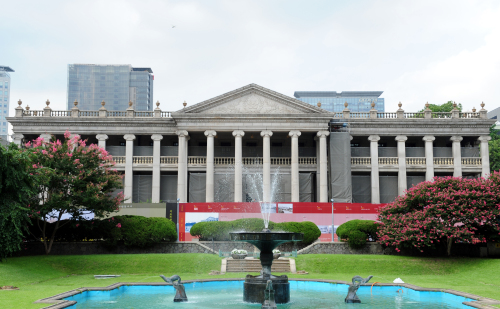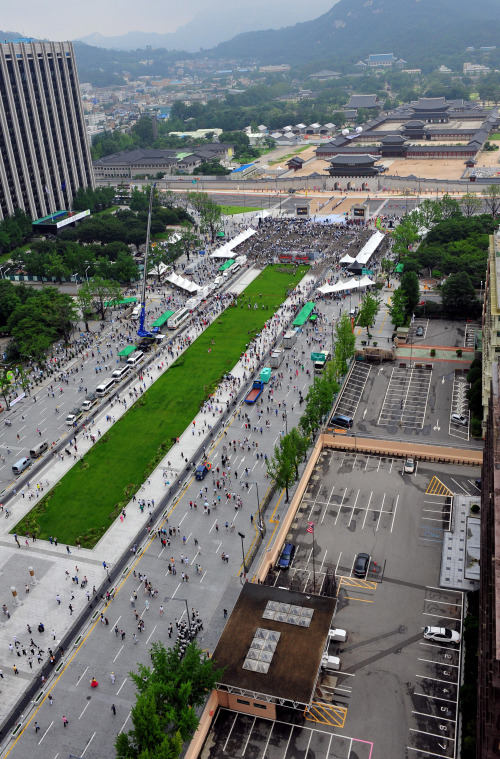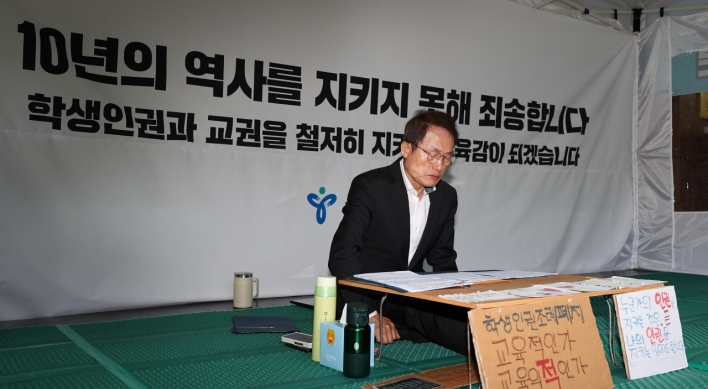[Korea-Japan 100 years on (9)] Efforts to correct wrongs done by Japanese
ByPublished : Aug. 19, 2010 - 16:48
The newly reconstructed Gwanghwamun, the main gate to the Gyeongbok Palace in Seoul, symbolizes Korea’s achievement in regaining its identity and might as an independent nation 65 years after Japanese colonialism.
It projects the greater future to come for Korea, as the grand-scale Gwanghwamun restoration project spurs national momentum to restore other ancient cultural properties.
“We believe our restoration project will fuel national pride in the Korean people and contribute to setting our history straight, and thereby, reinforce the strength of our nation,” said Kim Won-ki, director of the royal palaces and tombs management division at the Cultural Heritage Administration.
The newly restored Gwanghwamun was unveiled on Aug. 15, Korea’s Liberation Day from Japanese colonial rule (1910-1945), after about four years of intensive construction following a series of repair attempts throughout the decades.
The gate is often referred to as the “nation’s face” and harbors the painful and tumultuous episodes of Korea’s history.
“Starting with Gwanghwamun, we will be completing the first phase of our grand restoration plan of the central area of Gyeongbok Palace this year -- you could say the skeletal structures would be completed,” Kim said.
The government launched the first phase of the Gyeongbok Palace reconstruction project in 1992. Kim said putting the so-called “meat” on the structures, or the second phase, would begin next year. The government has set 2030 as the target year for completing the second phase.
There were 36 buildings in the Gyeongbok Palace before 1990, and excavation efforts have stretched the total to 89.
“Historical documents show there were over 500 buildings in the palace during King Gojong’s reign, but we are aiming to revive an accumulated total of 380 by 2030, which would be like recouping about 76 percent of the original palace,” Kim said, noting that about 90 percent of the original was destroyed during Japan’s rule.
It projects the greater future to come for Korea, as the grand-scale Gwanghwamun restoration project spurs national momentum to restore other ancient cultural properties.
“We believe our restoration project will fuel national pride in the Korean people and contribute to setting our history straight, and thereby, reinforce the strength of our nation,” said Kim Won-ki, director of the royal palaces and tombs management division at the Cultural Heritage Administration.
The newly restored Gwanghwamun was unveiled on Aug. 15, Korea’s Liberation Day from Japanese colonial rule (1910-1945), after about four years of intensive construction following a series of repair attempts throughout the decades.
The gate is often referred to as the “nation’s face” and harbors the painful and tumultuous episodes of Korea’s history.
“Starting with Gwanghwamun, we will be completing the first phase of our grand restoration plan of the central area of Gyeongbok Palace this year -- you could say the skeletal structures would be completed,” Kim said.
The government launched the first phase of the Gyeongbok Palace reconstruction project in 1992. Kim said putting the so-called “meat” on the structures, or the second phase, would begin next year. The government has set 2030 as the target year for completing the second phase.
There were 36 buildings in the Gyeongbok Palace before 1990, and excavation efforts have stretched the total to 89.
“Historical documents show there were over 500 buildings in the palace during King Gojong’s reign, but we are aiming to revive an accumulated total of 380 by 2030, which would be like recouping about 76 percent of the original palace,” Kim said, noting that about 90 percent of the original was destroyed during Japan’s rule.

Gwanghwamun emerged with the birth of Seoul. Taejo, the founder and first king of Korea’s Joseon Dynasty (1392-1910), built Gyeongbok Palace and its four surrounding gates. The project stood as Taejo’s first nation-building project in 1395. The king, who reigned from until 1398, would pass through Gwanghwamun, the main front gate meaning “light spreads over the world.”

But during Japan’s occupation, the Japanese moved the gate to a northeastern corner of Gyeongbok Palace in 1926 to expand its government administrative office. The gate took an additional blow as it lost an upper wooden section during the 1950-53 Korean War.

The Korean government in 1968 sought to build Gwanghwamun at its original location but had used concrete rather than wood and stone, the original materials.
“The gate was built entirely new at the original location by President Park Chung-hee. In the 1990s, the government launched the Gyeongbok Palace restoration project, while the Gwanghwamun rebuilding project was launched in 2006 to build the gate in its original form with the same type of materials that had been used,” Lee Jae-suh, an official of the Cultural Heritage Administration, said.
The 2006 launch was part of Korea’s efforts to remove traces of the country’s colonial past.
Restoring the nation’s capital into its 100 percent original Korean form, of course, is expected to be not only time-consuming but also like solving a mystery.
Restoration efforts at Deoksu Palace, not too far from Gyeongbok Palace, are also taking place. From 2007 to 2009, the government restored the exterior and interior of some of the buildings in Deoksu Palace. Go Jung-ju, an official of the royal palaces division of the Cultural Heritage Administration, said that restoration efforts have been underway since 2009 to bring back the original design and function of some structures.
“We’re aiming to restore by 2012 one of the buildings that was used as Emperor Gojong’s office in 1909,” Go said in a telephone interview. “The place has been used for various purposes since then, such as an art gallery in 1933, and then a national museum in the 1950s, and then as a national contemporary museum in 1973,” he explained.
A recently completed project includes a building used for personal purposes by Emperor Gojong in 1904.
“This venue was destroyed in a fire in 1925 for some unknown reason, but we sought to rebuild it in a two-year project between December 2007 and December 2009,” Go said.
It wasn’t until 2004 that the property came into government hands. It was owned by private investors until 2003.
“Managing rights were handed to the Cultural Heritage Administration in 2006, which allowed the state-run agency to begin restoration efforts,” Go said. “All these rebuilding attempts are very challenging because of issues over accuracy and missing pieces; everything we do requires research and time for finding missing links through excavation efforts.”
“What we do is provide the funds to local governments to restore and find cultural assets, and restoration efforts are not so easy because most times, it’s difficult to pinpoint the historical background of a cultural property due to our tumultuous history,” another official of the Cultural Heritage Administration, told The Korea Herald, asking not to be identified.
By Yoo Soh-jung (sohjung@heraldcorp.com)




![[KH Explains] No more 'Michael' at Kakao Games](http://res.heraldm.com/phpwas/restmb_idxmake.php?idx=644&simg=/content/image/2024/04/28/20240428050183_0.jpg&u=20240428180321)












![[Herald Interview] Mistakes turn into blessings in street performance, director says](http://res.heraldm.com/phpwas/restmb_idxmake.php?idx=652&simg=/content/image/2024/04/28/20240428050150_0.jpg&u=20240428174656)
